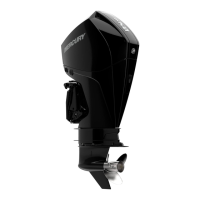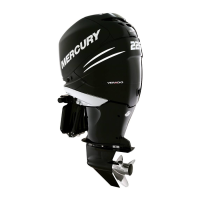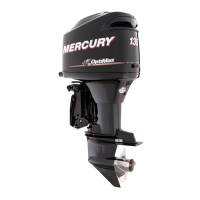• Intake air temperature (IAT) sensor
• Manifold absolute pressure (MAP) sensor
• Oil level sensor
• Oil pressure sensor
• Oil temperature sensor
• Oxygen sensor (O2)
• Pitot pressure sensor
• Shift demand sensor
• Throttle demand sensor
• Trim position sensor
• Water‑in‑fuel (WIF) sensor
The PCM controls these components:
• Electronic throttle control (ETC)
• Fuel injectors
• Fuel pump master relay
• Ignition coils
• Main power relays (MPR)
• Start relay
• Trim up and down relays (on DTS engines)
In addition, the PCM communicates with the helm or other modules through CANs P and H, as well as X on DTS systems.
When system faults threaten engine damage, software installed on the PCM reduces power by limiting the RPM. Refer to
Engine Guardian System.
You must have the CDS G3 system to communicate with the PCM and perform diagnostic tests.
Engine Guardian System
The Engine Guardian System monitors critical engine functions and will reduce engine power accordingly in an attempt to keep
the engine running within safe operating parameters.
IMPORTANT: The Engine Guardian System cannot guarantee that powerhead damage will not occur when adverse operating
conditions are encountered. The Engine Guardian System is designed to 1) warn the boat operator that the engine is operating
under adverse conditions and 2) reduce power by limiting maximum RPM in an attempt to avoid or reduce the possibility of
engine damage. The boat operator is ultimately responsible for proper engine operation.
The Engine Guardian System may also affect engine speed. Guardian goes into effect if one or more of the engine system
sensors indicates that reducing power is necessary to protect the engine.
The Engine Guardian System will reduce power in the event of:
• Engine coolant temperature overheating
• Low oil pressure
• Overspeed
• Battery voltage high/low
• All DTS critical faults
For example, if an open or short is found in any sensor, available power is reduced, the audio warning system will sound a
critical fault alert and the SmartCraft gauges will display a warning.
Important Terms
In discussing the PCM, there are a few terms to become familiar with:
•
Closed‑loop control: This is when the PCM is monitoring and adjusting the air/fuel ratio. When the engine is unable to
enter closed‑loop control, as when a sensor fails, the system reverts to default fuel delivery, a predetermined table of air/
fuel values, and is then in open‑loop control.
•
Error: The difference between the desired equivalency ratio and the actual equivalency ratio. It is also referred to as
ITerm.
•
Default fuel delivery: The term used for the amount of fueling that occurs along a predefined power curve from idle to
wide‑open throttle. When the system is unable to enter closed‑loop operation, it will revert to this table for values to be
used in determining the appropriate air/fuel ratio in accordance with the Speed/Density Theory.
System Theory
90-8M0146617 eng JULY 2018 © 2018 Mercury Marine Page 1B-5

